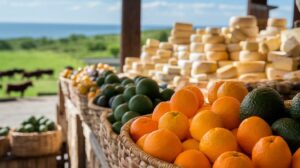Easter in Uruguay presents a fascinating mosaic of colonial heritage and modern celebrations, where religious devotion meets family tradition. The nation's unique spin on this Christian holiday brings together solemn Holy Week processions, mouth-watering asados, and the joyful chaos of egg hunts in urban parks. From the cobblestone streets of Montevideo's Ciudad Vieja to the sun-drenched plazas of Colonia del Sacramento, each corner of Uruguay adds its own distinctive flavor to these sacred festivities.
Key Takeaways
- Easter in Uruguay blends Catholic traditions with indigenous influences, featuring religious processions and family-centered celebrations during autumn.
- Families gather for traditional asados (barbecues) and share special foods like Pan de Pascua and fish empanadas during Holy Week.
- Religious observances include church services and processions, though celebrations are generally more modest compared to other Latin American countries.
- Popular Easter treats include decorated chocolate eggs, artisanal bombones with dulce de leche, and sweet breads reflecting Italian-Spanish heritage.
- Easter celebrations incorporate autumn seasonal elements, including harvest festivities and decorations using fallen leaves and seasonal fruits.
Historical Roots of Uruguayan Easter
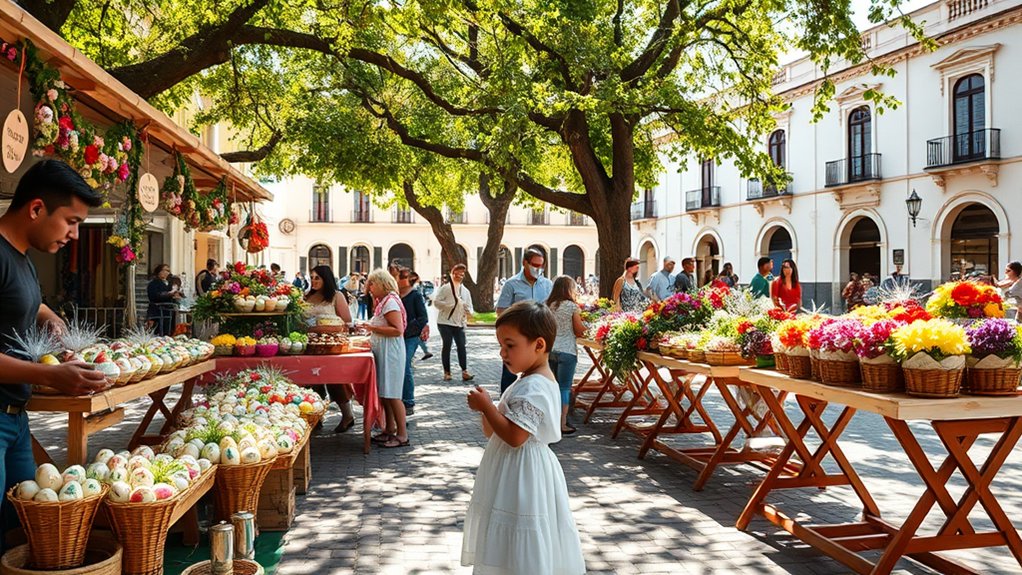
While the origins of Easter celebrations in Uruguay share common threads with other predominantly Catholic nations in Latin America, the country has developed its own distinct customs and traditions over time.
Spanish colonists brought Easter symbolism to Uruguay in the 16th century, interweaving Catholic practices with indigenous influences. The historical significance of these early celebrations laid the groundwork for modern observances, though many original customs have evolved. During the colonial period, Easter ceremonies were elaborate affairs that served both religious and social functions, helping to establish community bonds in the developing settlement.
As Uruguay moved toward independence and secularization in the 19th century, Easter traditions began incorporating more secular elements while maintaining their spiritual core, creating the unique blend of customs observed today.
Religious Customs During Holy Week
During Holy Week in Uruguay, Catholic communities gather for solemn processions through city streets, carrying religious statues and images while reciting prayers and hymns. The faithful observe traditional fasting practices, particularly on Good Friday, when many abstain from meat and engage in periods of contemplative prayer. Churches across the country hold special masses throughout the week, culminating in the joyous Easter Sunday celebrations that mark the end of the Lenten season.
Traditional Processions and Masses
Religious observances mark Holy Week in Uruguay, where Catholic traditions intertwine with local customs to create a unique Easter experience. Throughout the country, communities organize solemn processions that wind through city streets and rural towns, with participants carrying religious symbols and Easter art created by local artisans. These processions, varying in size and style depending on the region, often feature traditional music and prayers.
Churches hold special masses that attract both devout Catholics and those seeking cultural connection. The services blend centuries-old rituals with distinctly Uruguayan elements, fostering strong community involvement. Notable processions take place in Montevideo's Ciudad Vieja and the historic town of Colonia del Sacramento, where candlelit evening walks create an atmospheric backdrop for reflection and celebration.
Fasting and Prayer Customs
As Easter approaches in Uruguay, many devout practitioners observe traditional fasting customs that have evolved to reflect modern interpretations of religious devotion. While maintaining the spiritual significance of the season, contemporary Uruguayans adapt dietary restrictions to align with their lifestyles.
Common fasting practices during Holy Week include:
- Abstaining from meat on Good Friday
- Reducing portion sizes during meal times
- Replacing one daily meal with prayer and reflection
During this period, families often gather for evening prayers and meditation sessions in their homes, creating intimate spiritual spaces outside formal church settings. The blending of traditional Catholic fasting principles with Uruguay's progressive social climate has resulted in flexible observances that honor both religious heritage and personal choice in expressing faith.
Traditional Easter Foods and Recipes
While Uruguayan Easter celebrations echo aspects of their Spanish colonial heritage, the traditional Easter foods enjoyed across this South American nation reflect a unique blend of European and local influences. During Holy Week, families gather to share Easter bread, known locally as "pan de Pascua," a sweet loaf often studded with dried fruits and nuts. Traditional empanadas filled with fish or vegetables make frequent appearances on Easter tables, particularly during Friday observations.
Contemporary Easter celebrations frequently incorporate elements that reflect Uruguay's strong Italian heritage, such as pasta dishes served alongside traditional fare. Chocolate eggs and bunnies have also found their way into Uruguayan Easter traditions in recent decades, with local confectioners putting their own creative spin on these sweet treats.
Family Gatherings and Celebrations
Family bonds take center stage during Easter celebrations in Uruguay, though historical accounts of specific gathering traditions remain limited. Uruguayan families merge ancient customs with personal family traditions, creating vibrant celebrations in their homes. Easter decorations often reflect this blend, with both religious symbols and contemporary touches adorning living spaces.
- Families often gather for extended asados (barbecues), converting traditional Easter meals into day-long social events
- Many households maintain their own unique rituals, from Easter egg hunts adapted to local settings to special prayer ceremonies
- Multi-generational celebrations are common, with grandparents passing down stories and traditions to younger family members
While each family celebrates differently, the emphasis remains on togetherness, shared meals, and creating lasting memories during this significant holiday period.
Modern Easter Practices in Urban Areas
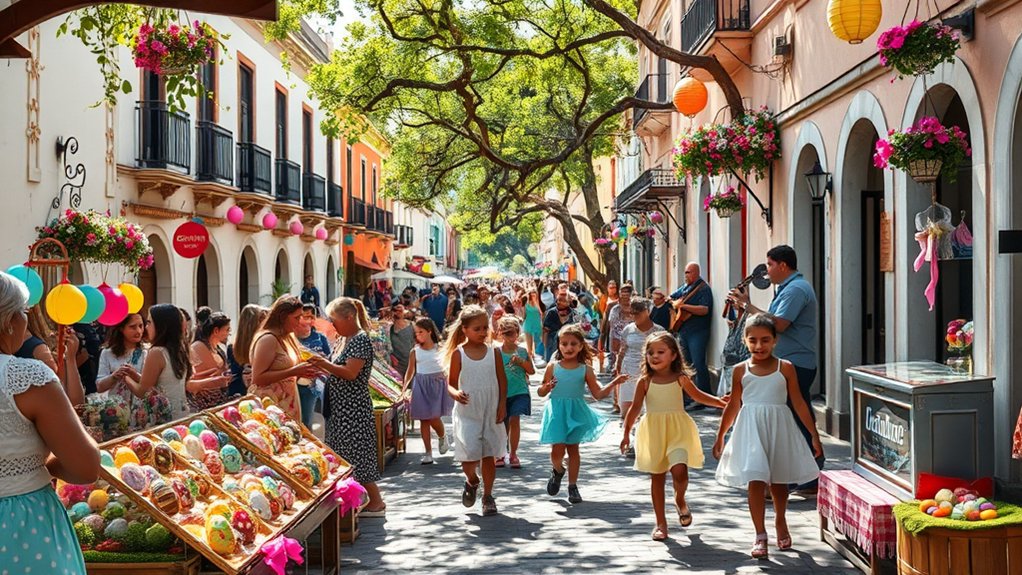
Modern urban life in Uruguay has reshaped how city dwellers experience Easter celebrations. Shopping centers and community spaces now host elaborate Easter craft workshops, where children and adults create decorative eggs and seasonal ornaments using contemporary materials and techniques. Many neighborhoods organize community events that blend traditional religious observances with modern entertainment, featuring live music, food trucks, and interactive activities.
Urban Uruguayans increasingly adopt a mix of secular and religious celebrations, with some families splitting their time between church services and public festivities. Local businesses and cultural centers often coordinate Easter-themed exhibitions, markets, and workshops that attract diverse crowds. These modern interpretations of Easter traditions reflect Uruguay's evolving urban culture while maintaining connections to the holiday's spiritual significance through creative expression and communal gathering.
Rural Easter Traditions
Traditions in Uruguay's countryside paint a different picture of Easter celebrations compared to their urban counterparts. As reliable information about rural Easter customs in Uruguay is limited, it would not be appropriate to make specific claims about Easter crafts or rural folklore in these areas without verified sources. While Easter is likely celebrated in rural Uruguay, the exact nature and details of these celebrations cannot be accurately described without proper documentation.
Rural Easter celebrations in Uruguay likely differ from urban ones, but limited documentation prevents detailed claims about specific customs.
- Historical records of rural Easter traditions are sparse
- Local practices may vary significantly by region
- Documentation of specific customs needs further research
Until more verified information becomes available, any detailed descriptions of rural Easter celebrations in Uruguay would be speculative and potentially misleading to readers interested in authentic cultural practices.
Easter's Connection to Autumn Season
In Uruguay, Easter arrives as autumn paints the terrain in rich golds and browns, creating a distinctly different atmosphere from Northern Hemisphere celebrations. This timing aligns perfectly with the country's harvest season, allowing Uruguayans to incorporate fresh autumn produce and seasonal traditions into their Easter festivities. Local families often combine traditional Easter customs with autumn harvest celebrations, gathering for meals that feature both Easter classics and seasonal specialties like newly harvested squash, sweet potatoes, and the last fruits of summer.
Easter Harvest Celebrations
While many Northern Hemisphere countries celebrate Easter during springtime, Uruguay experiences this holiday during its autumn season, creating a unique cultural backdrop for Easter celebrations.
During this harvest period, Uruguayans blend traditional Easter practices with autumn-themed festivities, incorporating local customs and seasonal elements into their celebrations.
- Easter gardening activities focus on preparing winter crops and preserving autumn's bounty
- Harvest rituals often include gathering and sharing seasonal fruits like apples, pears, and grapes
- Families create decorations using fallen leaves and autumn colors, merging Easter symbolism with harvest themes
The timing of Easter in Uruguay's autumn season has naturally evolved into distinctive harvest-centered traditions that reflect both the religious significance of the holiday and the practical aspects of seasonal change.
Autumn Weather and Traditions
As Uruguay enters its autumn months during Easter, temperatures typically range between 15-20°C (59-68°F), creating a distinctly different atmosphere from Northern Hemisphere celebrations. The fall season brings unique Easter symbolism to Uruguayan traditions, blending Christian customs with harvest celebrations characteristic of autumn festivals in the Southern Hemisphere.
| Autumn Element | Easter Connection |
|---|---|
| Falling Leaves | Renewal symbols |
| Harvest Time | Abundance themes |
| Cooler Weather | Indoor gatherings |
| Shorter Days | Evening ceremonies |
This seasonal timing means many traditional Easter activities take place indoors, where families gather to share mate tea and traditional pastries. Communities often incorporate autumn-themed decorations into their Easter celebrations, using locally harvested crops and fallen leaves alongside typical Easter elements, creating a distinctive South American interpretation of the holiday.
Popular Easter Desserts and Sweets
Easter delicacies in Uruguay reflect international influences rather than established local traditions, since the holiday itself has historically played a more subdued role in Uruguayan culture compared to other Catholic celebrations.
During the Easter season, bakeries and confectioneries across Uruguay offer various treats that blend European and local flavors. Sweet breads reminiscent of Italian and Spanish heritage make their way to family tables, while chocolate figurines shaped as eggs and bunnies compete for attention in shop windows.
Popular Easter treats include:
- Huevos de Pascua – decorated chocolate eggs filled with candies
- Pan Dulce de Pascua – sweet bread studded with dried fruits
- Bombones artesanales – handcrafted chocolates often featuring dulce de leche fillings
These sweets showcase Uruguay's cosmopolitan approach to holiday celebrations, embracing both imported customs and regional touches.
Church Services and Religious Events
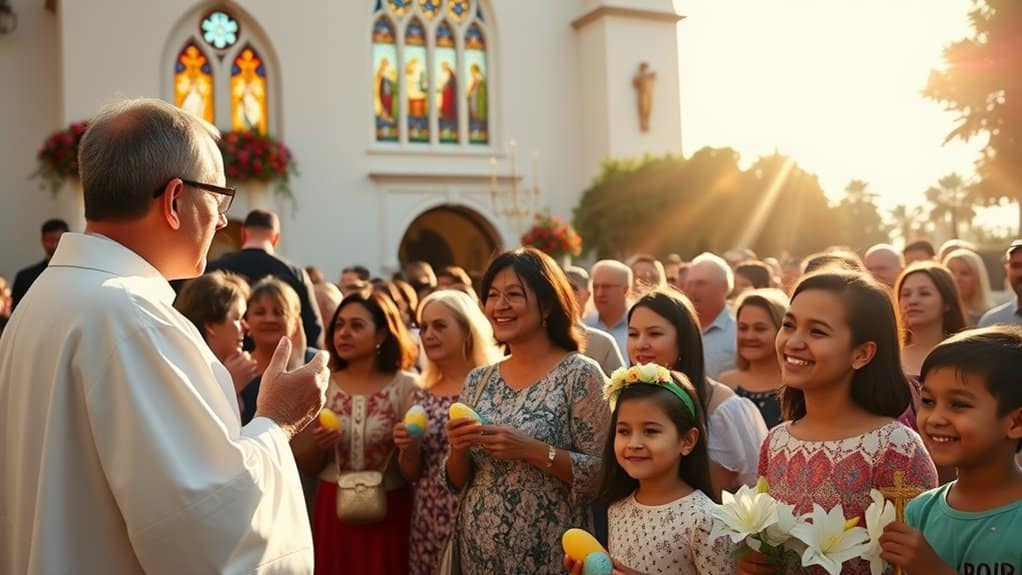
Religious observances during Holy Week involve primarily Catholic services across Uruguay's churches, though participation tends to be modest compared to other Latin American nations. The Easter history in Uruguay reflects a blend of European Catholic traditions brought by Spanish colonizers and local customs that evolved over centuries.
Many churches hold special masses and processions during Holy Week, with the most significant services taking place on Good Friday and Easter Sunday. While the spiritual significance of Easter remains important to practicing Catholics, Uruguay's secular society means these observances are often more cultural than strictly religious. Some churches organize evening vigils and sunrise services, though these tend to be smaller, intimate gatherings rather than large-scale events. Modern celebrations often emphasize family gatherings over formal religious ceremonies.
Cultural Fusion: European and Local Customs
While Uruguay's Easter customs originated from European traditions, particularly Spanish Catholic influences, the celebration has evolved into a unique cultural mosaic that reflects the country's distinct identity.
The blending of European heritage with local customs has created distinctive Easter celebrations throughout Uruguay, where cultural significance varies by region and community. This fusion manifests in several notable ways:
- Traditional Spanish Holy Week processions now incorporate indigenous musical instruments and rhythms
- Easter meals combine European dishes like bacalao with local Uruguayan ingredients and cooking methods
- Religious symbols and decorations often feature a mix of classical Catholic imagery alongside South American artistic elements
This cultural synthesis demonstrates how Uruguayans have adapted centuries-old traditions while maintaining their authenticity, creating celebrations that honor both their European roots and their unique national identity.
Easter Markets and Shopping Traditions
Few shopping traditions in Uruguay rival the bustling activity that emerges during Semana Santa, when local markets convert into vibrant gathering spots for seasonal goods. Local artisans display their Easter crafts across temporary stalls and permanent market spaces throughout urban centers.
| Market Location | Popular Items |
|---|---|
| Montevideo Port | Seafood, Wine |
| Ciudad Vieja | Religious Art |
| Mercado Central | Easter Bread |
| Coastal Markets | Shell Crafts |
While traditional Easter markets have evolved with modern times, many still maintain authentic elements that reflect Uruguay's heritage. Visitors can find handcrafted religious items, seasonal treats, and decorative pieces that blend contemporary design with historical significance. The markets serve as social hubs where families gather to shop, share meals, and participate in the cultural experience of Easter preparations.
Easter Weekend Activities and Celebrations
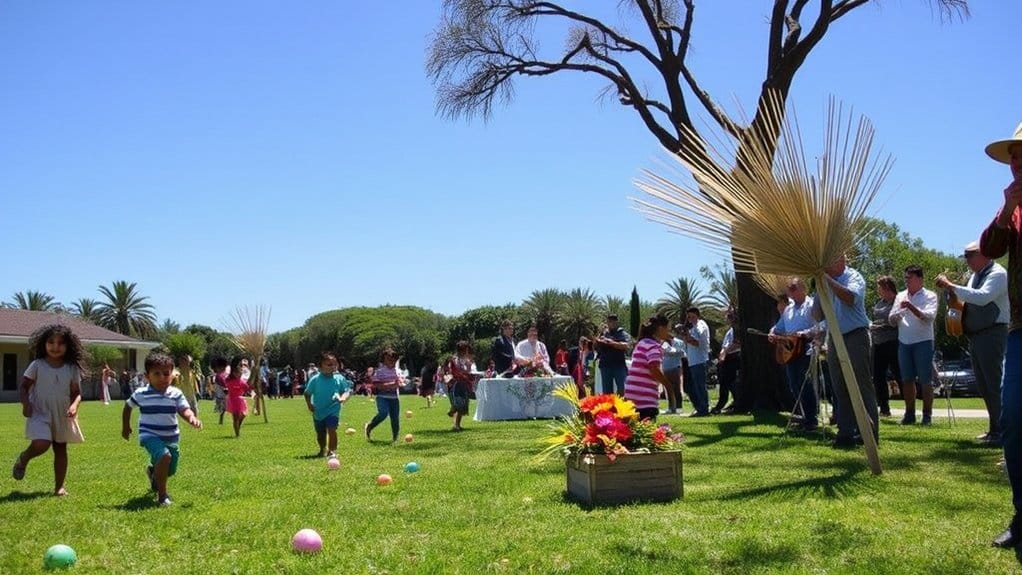
Easter weekend in Uruguay pulses with vibrant celebrations that blend sacred traditions with communal festivities. The country's unique fusion of cultural influences shapes distinctive Easter traditions and local folklore, creating celebrations unlike anywhere else in South America.
Throughout the weekend, communities across Uruguay come together for a mix of religious observances and secular celebrations:
During Easter, Uruguayans unite in celebration, weaving together both sacred rituals and festive community gatherings across the nation.
- Families gather for asados (traditional barbecues) featuring lamb and local specialties
- Candlelit processions wind through historic neighborhoods, with participants carrying ornate religious symbols
- Street festivals showcase folkloric music and dance, bringing neighborhoods alive with cultural performances
These celebrations reflect Uruguay's independent spirit, where centuries-old customs merge with modern interpretations, creating a dynamic Easter experience that continues to evolve while honoring its roots.



